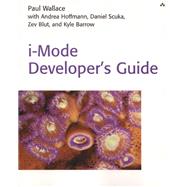
Paul Wallace holds a Ph.D. in Instructional Technology and is actively engaged in research on usability and personalization for mobile and small screen applications. He is currently based in Tokyo, specializing in mobile personalization solutions for market leading companies in Japan, Europe, and North America.
Paul is a visiting instructor at the International University of Japan (IUJ)Graduate School of International Business, where he teaches a course oneCommerce technologies. He has conducted numerous workshops and presentations on desktop and mobile interaction design, and has published articles and original research on mobile usability and personalization. He was a contributing author for the best-selling Special Edition Using Netscape series of books, published by Que.
Originally from Virginia, Paul relocated to Japan in 1998 to lead thedevelopment of Internet applications for the International University of Japan(http://www.iuj.ac.jp). The online recruiting and admissions system that he designed there was the first ofits kind in Asia and lead to his interest in mobile application architecture and user experience. Currently he divides his time between the IUJ campus, located in the picturesque Echigo-sanzan Mountains of Niigata prefecture, and dizzying Tokyo metropolis.
In his time away from work Paul enjoys traveling, particularly in SoutheastAsia. He is an avid swimmer, surfer, and all-around beach lover who dreams ofspending a few months away from it all this summer on the coast of Java andLombok Island in Indonesia.
Paul maintains the supporting Web site for this book (http://www.imode-guide.com), where you can download software and tools for creating i-mode applications, as well as keep up with updates and resources related to this publication. He can be reached via email (pwallace@imode-guide.com), and welcomes your comments and suggestions concerning this book, and regarding mobile application development in general.
| Introduction | 1 | (8) | |||
| Part I The i- mode Mobile Internet | |||||
|
9 | (16) | |||
|
25 | (20) | |||
|
45 | (30) | |||
|
75 | (34) | |||
| Part II Towards 3G Mobile Services | |||||
|
109 | (20) | |||
|
129 | (26) | |||
|
155 | (30) | |||
|
185 | (18) | |||
| Part III How to Build i-mode Sites | |||||
|
203 | (16) | |||
|
219 | (16) | |||
|
235 | (18) | |||
|
253 | (18) | |||
|
271 | (22) | |||
|
293 | (34) | |||
|
327 | (24) | |||
|
351 | (26) | |||
|
377 | (28) | |||
|
405 | (28) | |||
|
433 | (20) | |||
|
453 | (30) | |||
| Part IV Building Dynamic i-mode Applications | |||||
|
483 | (28) | |||
|
511 | (30) | |||
|
541 | (10) | |||
|
551 | (26) | |||
| Part V Using Java for i-mode | |||||
|
577 | (16) | |||
|
593 | (36) | |||
|
629 | (104) | |||
| Part VI Appendices | |||||
|
687 | (20) | |||
|
707 | (8) | |||
|
715 | (4) | |||
|
719 | (10) | |||
|
729 | (4) | |||
| Index | 733 |
The New copy of this book will include any supplemental materials advertised. Please check the title of the book to determine if it should include any access cards, study guides, lab manuals, CDs, etc.
The Used, Rental and eBook copies of this book are not guaranteed to include any supplemental materials. Typically, only the book itself is included. This is true even if the title states it includes any access cards, study guides, lab manuals, CDs, etc.